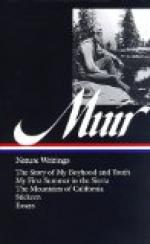displaying beautiful iridescent colors as they moved
their necks backward and forward when we went very
near them. Every shotgun was aimed at them and
everybody feasted on pigeon pies, and not a few of
the settlers feasted also on the beauty of the wonderful
birds. The breast of the male is a fine rosy
red, the lower part of the neck behind and along the
sides changing from the red of the breast to gold,
emerald green and rich crimson. The general color
of the upper parts is grayish blue, the under parts
white. The extreme length of the bird is about
seventeen inches; the finely modeled slender tail
about eight inches, and extent of wings twenty-four
inches. The females are scarcely less beautiful.
“Oh, what bonnie, bonnie birds!” we exclaimed
over the first that fell into our hands. “Oh,
what colors! Look at their breasts, bonnie as
roses, and at their necks aglow wi’ every color
juist like the wonderfu’ wood ducks. Oh,
the bonnie, bonnie creatures, they beat a’!
Where did they a’ come fra, and where are they
a’ gan? It’s awfu’ like a sin
to kill them!” To this some smug, practical
old sinner would remark: “Aye, it’s
a peety, as ye say, to kill the bonnie things, but
they were made to be killed, and sent for us to eat
as the quails were sent to God’s chosen people,
the Israelites, when they were starving in the desert
ayont the Red Sea. And I must confess that meat
was never put up in neater, handsomer-painted packages.”
In the New England and Canada woods beechnuts were
their best and most abundant food, farther north,
cranberries and huckleberries. After everything
was cleaned up in the north and winter was coming on,
they went south for rice, corn, acorns, haws, wild
grapes, crab-apples, sparkle-berries, etc.
They seemed to require more than half of the continent
for feeding-grounds, moving from one table to another,
field to field, forest to forest, finding something
ripe and wholesome all the year round. In going
south in the fine Indian-summer weather they flew
high and followed one another, though the head of the
flock might be hundreds of miles in advance.
But against head winds they took advantage of the
inequalities of the ground, flying comparatively low.
All followed the leader’s ups and downs over
hill and dale though far out of sight, never hesitating
at any turn of the way, vertical or horizontal that
the leaders had taken, though the largest flocks stretched
across several States, and belts of different kinds
of weather.
There were no roosting-or breeding-places near our
farm, and I never saw any of them until long after
the great flocks were exterminated. I therefore
quote, from Audubon’s and Pokagon’s vivid
descriptions.
“Toward evening,” Audubon says, “they
depart for the roosting-place, which may be hundreds
of miles distant. One on the banks of Green River,
Kentucky, was over three miles wide and forty long.”




